Asus Rampage IV Black Edition Review
Sandy Bridge E remains an interesting topic of discussion. Introduced in Q4 2011, this was camp blue’s enthusiast platform, offering the crème-de-la-crème for the crowd who didn’t mind paying a premium. Now, in 2014, when the mainstream segments have already passed two generations (Ivy Bridge, Haswell), Intel hasn’t updated the enthusiast platform in a similar way. Even with the introduction of Ivy Bridge E, the next step in processor architecture, we are still seeing no new chipsets being launched. The existing X79 boards are getting BIOS or firmware upgrades to work with the newer batch of processors, alongside the launch of a handful of new boards. So before Haswell E arrives (Q2 2014?) the enthusiast platform remains X79, now two and a half years old.
Asus are the forerunners when it comes to motherboards, both in terms of features and revenues (motherboards sold in million units). They have diversified their entire motherboard range in a few distinct sections, each trying to cater to a different crowd, keeping a couple of base features which are enforced on every segment to make sure they retain the same quality, and then according to the segment, adding couple of brownie points. So we have their Republic of Gamers range, the TUF (The Ultimate Force)range, and their mainstream range (Pro/Deluxe/WS), each coming with different color schemes (red/black for ROG, black/gold for mainstream, grey/army green for TUF). Asus also uses different VRM circuitry/audio components and/or software tweaks on certain products to differentiate them from others in their huge array of motherboards.
For ROG, the differentiation runs deep – even in names. While Maximus is the name given to mainstream ROG boards, the enthusiast chipset ROG boards get a more intimidating Rampage moniker. The rest remains the same – Gene for Micro ATX, Formula as their top-dog gaming solution with premium audio in terms of SupremeFX, and Extreme as the flagship enthusiast/benching/uber-high end gaming motherboard (additions to this range are Hero – the budget ATX board and Impact – the mini ITX ROG board, introduced in the Z87/Haswell range). For Ivy Bridge E, however, Asus has introduced a single ROG motherboard (X79-Deluxe being the only other motherboard released), and we have it today in our labs for testing.
Behold, the Rampage IV Extreme Black Edition.
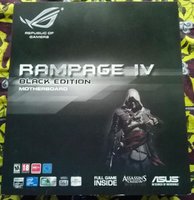
Board Specifications, visual layout:
Here are the board specs, listed by Asus:
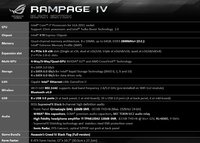
The original Rampage IV Extreme has been Asus’ best-selling X79 board, and despite the steep asking price (Rs.28, 000 now, Rs.35k+ initially), it was immensely popular amongst enthusiasts and gamers alike. With the Black Edition, Asus have tried to provide something extra, even on top of the already gargantuan feature set for the original flagship. If someone remembers the Rampage III Black Edition, it was the added ThunderBolt module which added Xonar grade sound and dedicated Killer NIC in an add-on PCI-E card. For the newest member of the family, it comes in two folds – the integrated SupremeFX sound module, and their OC Panel, which we’ve already seen debuting with the Maximus VI Extreme. We will come to these areas later, but for now, let’s look at the board in whole.
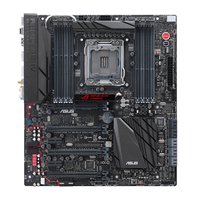
The Rampage IV Black Edition, or RIVBE as many enthusiasts call it, follows the same Extended ATX form factor as the original Rampage IV Extreme. The layout is pretty same, but Asus has thrown in plenty little things into the mix. Though it is a ROG branded board, the red and black liveries are replaced with predominantly black, and tints of ash (like in the DRAM slots) to maintain the ‘Black Edition’ theme. We will see later on that this trend continues in the UEFI/BIOS as well, amongst other things. Visually, the heatsink(s) have changed too from the original Rampage IV Extreme. The power delivery now has a smaller heatsink which is connected to a beefier one which also acts as a shroud to hide the silver IO connectors. That’s a neat trick, and Asus also employs a slick engraved ‘Rampage IV Black Edition’ on top of it to make it more aesthetically appealing. On the RIVBE, the chipset heatsink is detached/standalone, and the design philosophy follows that of their Z87 boards rather than RIVE, which had a connected heatsink and active cooling in the form of a chipset fan. The socket area features Asus’ modified X79 socket plate – you will notice that the metal extension to the socket holes in other X79 products is not here – one would imagine this is due to the styling, but also the back plate changes such that 775 coolers with 2011 socket extensions can be used easier (such as the X-Socket arrangement with the RIVE).
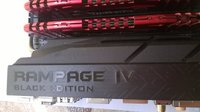
As with all Asus motherboards, the DRAM sockets continue to have single-sided latches, which make it easier to remove the memory sticks with large GPUs installed, but also introduces the need to push the sticks fully into the latches to ensure a firm connection is made. There are eight fan headers in total in RIVBE, two (CPU 4-in, CPU_OPT 4pin) on top of the motherboard, another 4-pin just below the debug LEDs, two more near the 24-pin ATX power connector, and two on the bottom of the board, with the eighth one to the bottom left of the DRAM slots near the IO. That gives an end user plenty of options to hook up fans with the motherboard which can then be monitored using Asus’ bundled utilities.
A two digit display is on the right hand top corner of the motherboard, alongside some other OC oriented componentry. That area looks particularly busy with LN2 mode jumper, slow mode switch and voltage read points, along with PCIe enable/disable switches and MemOK! Button (for booting with safe memory settings). Further down, we have the standard ATX 24-pin power connector and the USB 3.0 header (ASMedia controller) in their normal places.
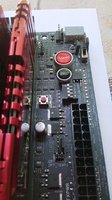
RIVBE provides a total of ten SATA ports, with the four SATA 3 Gbps from the chipset in a darker color, followed by the two SATA 6 Gbps from the chipset and another four SATA 6 Gbps ports powered by ASMedia.
The bottom of the board also gets the same ‘busy’ treatment, but here the things different from the RIVE are the inclusions of a ROG_EXT header (for the OC panel), a four-pin Molex power connector for VGA, and a Trusted Platform Module header. Rest of the stuff (two removable BIOS chips, rear IO, front panel header points, two USB 2.0 headers, two 4-pin fan headers, DirectKey and BIOS_Switch buttons) are pretty much standard fare.
The board supports all the possible GPU setups (SLI/CrossFireX), with x16/x16 for dual GPUs, x16/x8/x16 for triple, and x16/x8/x8/x8 for quad GPUs. There are no PLX chips like some of the other high end boards have employed (Asrock’s X79 Extreme11, for example, has TWO), so the lanes are fed by the CPU itself rather than offloaded to another chip. Two PCIe 2.0 x1 slots are also present, should any user require add-in cards.
Barring the I/O connectors, the left hand side of the motherboard is predominantly given to audio, and Asus employs their SupremeFX Black audio solution in the RIVBE. This is something new, since previously the Extreme boards never had premium audio (highest end board to have them was the Formula) but guess Asus went full circle to provide all high end features in a single board. As with the implementations, the audio section has a separate PCB and the separation has a series of LEDs underneath which light up once the board is powered on.
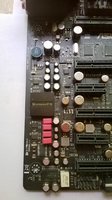
The rear I/O has the top covered by the RIVBE heatsink cover (the one with engravings), and from left to right we have the PS/2 port, four USB 2.0 ports, an ROG Connect Button, a USB BIOS Flashback button, six USB 3.0 ports (from ASMedia controllers/hubs), two eSATA ports (ASMedia), an Intel Gigabit Ethernet port, the 802.11ac dual band 2T/2R module with BT4.0 and audio jacks.
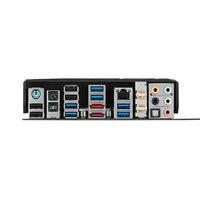
We will look at the SupremeFX Black Audio and the OC Panel in some more detail before moving on to the benchmarks.
SupremeFX Black Audio and OC Panel:
The Audio Circuitry centers around a Cirrus Logic® CS4398 DAC: 120 dB SNR, -107 dB THD+N (Max. 192 kHz/ 24 -bit), a TI 6120A2 high fidelity headphone amplifier (80 mW into 600 ohm from a ±12-V Supply at 0.00014% THD + N), high quality filter capacitors in both directions (ELNA® premium audio capacitors, WIMA® film capacitors), and NEC TOKIN UC2 audio relay, all within an EMI shield and housed within a separate PCB. The audio codec used here is REALTEK ALC1150.
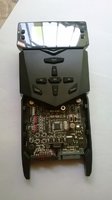
Asus has quite a busy PCB going on for the RIVBE, but smartly, they have also taken quite a few of them out of the physical board itself and put them in a separate solution which they call the OC Panel. First introduced with the Z87 flagship Maximus VI Extreme, the OC Panel PCB basically has the Slow Mode/LN2 mode/Subzero Sense/VGA Hotwire operators, a couple of fan headers (Needs the SATA power connection to be plugged in to feed them), and the package is neatly topped with a LCD display with a couple of buttons to change BCLK/Multiplier settings on the fly without getting into the BIOS/UEFI. The LCD also displays the current values of the BCLK/Multiplier, along with CPU temperature, and fan speed(s), depending upon the settings. OC Panel uses its own proprietary connector onboard to get information from the system, hence only a couple of select motherboards (All Maximus VI models, RIVBE) are supported at this point of time but something tells me that we will see it implemented in more systems in the future. Asus also supplies a neat single 3.5” bay adapter for the OC Panel to integrate it inside the computer case should anyone doesn’t want to use it standalone (though I should say that unless you’re using an open test bench, the connector cable might be a little short for a tabletop use).

What’s in the box, BIOS/UEFI and bundled software:
In the box, you get:
• User's manual
• I/O Shield
• 4 x SATA 3Gb/s cable(s)
• 6 x SATA 6Gb/s cable(s)
• 1 x ASUS 2T2R dual band Wi-Fi moving antennas (Wi-Fi 802.11a/b/g/n/ac compliant)
• 1 x 3-Way SLI bridge(s)
• 1 x 4-Way SLI bridge(s)
• 1 x SLI bridge(s)
• 1 x CrossFire cable(s)
• 1 x Q-connector(s) (2 in 1)
• 1 x ROG Connect cable(s)
• 1 x 12 in 1 ROG Cable Label(s)
• 1 x X-Socket pad(s)
• 1 x ROG Magnet
• OC Panel Kit:
• - 1 x OC Panel(s)
• - 1 x OC Panel 5.25-inch bay metal case
• - 1 x OC Panel Cable(s)
Like their entire ROG line, the RIVBE BIOS is filled with copious options for first time and seasoned overclockers alike. For someone who uses the RIVE in his primary rig, the BIOS changes (I should really call them additions) are subtle yet present. Even then, the sheer number of options available can be overwhelming at times, and clearly even Asus doesn’t intend most of the options to be tinkered with. But it’s there, if someone needs it.
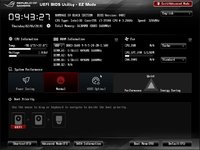
The biggest addition in my opinion is SSD Secure Erase, which lets you put an SSD without integrated encryption back to its original out-of-box state, initially restoring its performance to the highest possible level and the best (lowest number) possible write amplification. This is used best with the SSDs on the Asus’ list of passed drives.
As for bundled software, Asus includes their proprietary system monitoring/auto overclocking utility, a.k.a AI Suite III in the DVD, alongside a couple of others, like GameFirst II (cFosSpeed with a ROG wrapper), ROG RamDisk (self-explanatory), and copies of ROG themed CPU-Z, and their MemTweakIt (Memory benching utility). A full year license of Kaspersky Antivirus is included too, and a full version of Daemon Tools Pro.
AI Suite III is the newest version of Asus’ system monitoring and auto-overclocking utility, and uses what Asus calls ‘Four Way Optimization’. The four tools Asus emphasizes through this are-
TPU is to monitor CPU voltages, frequencies and the likes.
EPU is to monitor energy consumption and performance.
Digi+ Power Control is for power delivery customization.
Fan Xpert2 is to monitor every single fan plugged to the motherboard and control the fan profiles.
USB 3.0 Boost, EZ Update, USB BIOS Flashback, USB Charger+, and WiFi Go!/WiFi Engine are additionally included in the software suite which provide the options to update the drivers/BIOS, set up WiFi access points and charge through USB3.0 ports/provide a boost in performance.
Test configuration, Benchmarks:
I tested the Rampage IV Black Edition with the following hardware:
Processor Intel Core i7 3930K,6C/12T, 3.2 GHz (3.8 GHz Turbo), 6 x 256KB L2, 12 MB L3 cache
Motherboard Asus Rampage IV Black Edition, BIOS 0403
RAM GSkill Ripjaws-Z PC3-12800, 16 GB, 1600 MHz, CL9-9-11-27
GPU HIS AMD Radeon HD 6870 Ice QX, Barts, 975/1150 MHz
HDD Kingston SSDNow V300 64 GB SSD, SATA3
CPU Cooler Swiftech H320 Closed-loop CPU cooler
OS Windows 7 x64, SP1
Overclocking:
Overclocking the RIVBE was pretty similar to what I’ve seen in the RIVE. For starters, you can try the safest way – through multipliers. To push the system further, SB-E/IB-E allows BCLK based overclocking as well, though not all motherboards/CPUs can reach similar levels. One point also to remember is that my processor is a 130W part and does require substantial cooling once you start going beyond 4.5 GHz. That being said, here are the overclocks I got with RIVBE, and an i7-3930K:
The maximum overclock achieved was 5.013 GHz @ 1.6 volts (100.26 BLCK, 50x multiplier), though it was not bench stable and gave me BSOD as soon as I ran anything CPU intensive.
The maximum stable overclock was 4.9 GHz @ 1.48 volts (100 BLCK, 49x multiplier). This was perfectly bench stable and for overclocked results, I took this as my reference.
The results are not overwhelming, but considering the limited amount of cooling at hand, they were pretty impressive. Sadly, it couldn’t beat my trusty old RIVE, which had the same processor running stable @ 5.0 GHz, and reached a maximum of 5.15 GHz @1.5 volts. I reckon an IB-E processor would’ve fared better here with RIVBE.
Benchmarks (CPU/Gaming)
SiSoftware Sandra:
Rampage IV Extreme, Stock, BIOS 4402: Processor Arithmetic 134.47 GOPS , Processor Multimedia 342.87 MPix/s , Cryptographic Bandwidth 3.391 GB/s , Aggregate Memory Performance 6.147 GB/s, Total Aggregate 10.13 KPT.
Rampage IV Black Edition, Stock, BIOS 0403:Processor Arithmetic 134.65 GOPS , Processor Multimedia 336.57 MPix/s , Cryptographic Bandwidth 3.716 GB/s , Aggregate Memory Performance 8.888 GB/s, Total Aggregate 10.5 KPT.
AIDA64:
CPU-Queen
RIVE @Stock - 55198
RIVBE @Stock - 55195
RIVBE @4.9 GHz - 84836
CPU PhotoWorxx
RIVE @Stock - 19362 Mpixel/s
RIVBE @Stock - 22271 Mpixel/s
RIVBE @4.9 GHz - 30576 Mpixel/s
CPU Zlib
RIVE @Stock - 393.2 MB/s
RIVBE @Stock - 396.6 MB/s
RIVBE @4.9 GHz - 584.2 MB/s
CPU AES
RIVE @Stock - 18746 MB/s
RIVBE @Stock - 18750 MB/s
RIVBE @4.9 GHz - 28574 MB/s
CPU Hash
RIVE @Stock - 3487 MB/s
RIVBE @Stock - 3488 MB/s
RIVBE @4.9 GHz - 5054 MB/s
Memory Read
RIVE @Stock - 36366 MB/s
RIVBE @Stock - 46052 MB/s
RIVBE @4.9 GHz - 56146 MB/s
Memory Write
RIVE @Stock - 35812 MB/s
RIVBE @Stock - 46385 MB/s
RIVBE @4.9 GHz - 56913 MB/s
Memory Copy
RIVE @Stock - 34232 MB/s
RIVBE @Stock - 42894 MB/s
RIVBE @4.9 GHz - 52562 MB/s
CineBench R11:
RIVE @Stock - 9.29
RIVBE @Stock - 9.31
RIVBE @4.9 GHz - 13.63
Gaming Performance:
3DMark11, Performance Preset : 4941 Overall.
Unigine Heaven, 720p, DX11, Extreme : 835.3623
AC4 Black Flag, 2560x1440, High, FXAA/SSAO, god rays low : Maximum FPS 30, Minimum FPS 17, Average FPS 20.
Conclusion
With the Black Edition motherboards, Asus’ direction is pretty clear. This is not just any run of the mill enthusiast board, but one of the highest end that you can buy (barring the Extreme11 by AsRock), so Asus clearly targets a niche crowd who are either looking at an upgrade from their existing X79 platform, even present RIVE users – or are looking to build a system coming from older chipsets. The SupremeFX Black audio, the OC Panel, the added tweaks in the BIOS, and a newer suite of software all push the already huge feature set of the RIVE even further into RIVBE. Asus are confident to take this stride – RIVE remains their best sold X79 board ever, so they expect RIVBE to follow suit.
With the price out of the way, RIVBE is a great board to work with. I never faced any issues with it whatsoever, and with the hardware I had at hand it worked flawlessly from day one. The board is filled to grill with features, and while I do believe a single user might not be able to use all the nooks and crannies of what the BIOS/UEFI offers, they are there, should anyone need it. I’ll be frank – I never had a liking for the AI Suite, but the latest iteration looks and works much better. Then there are cFosSpeed (GameFirst II), ROG RamDisk, SSD Secure Erase and other features. The SupremeFX Black audio works well out of the box and the OC Panel almost alleviates the need to have a standalone fan controller/system display (I’m reluctant to say it can replace the UEFI based overclocking, but for simple multiplier based OC, it works fine).
With a week that I’ve spent this board with, my inner enthusiast has fallen in love with how good this board is and how easy it is to get it up and running and have a stable OC. In most of the benchmarks, the RIVBE managed to edge past the RIVE in stock settings, and while my 3930K didn’t quite reach the same levels of OC compared to my trusty ol’ RIVE, 4.9 GHz stable was no mean feat. I crossed 5 GHz too, albeit without it being bench stable. A re-testing with 4930K/4960X might prove otherwise. That remains a topic for a review redux.
So in a nutshell, Asus Rampage IV Black Edition is a board for the enthusiast who doesn’t shy away from the fact that to get premium features, you need to pay a premium. You may not need this many features in a board, but then RIVBE is not for everyone, just like Lamborghini or Ferrari isn’t for everyone.
A big thanks to Asus India for providing me the board.
Rating - 9/10
Sandy Bridge E remains an interesting topic of discussion. Introduced in Q4 2011, this was camp blue’s enthusiast platform, offering the crème-de-la-crème for the crowd who didn’t mind paying a premium. Now, in 2014, when the mainstream segments have already passed two generations (Ivy Bridge, Haswell), Intel hasn’t updated the enthusiast platform in a similar way. Even with the introduction of Ivy Bridge E, the next step in processor architecture, we are still seeing no new chipsets being launched. The existing X79 boards are getting BIOS or firmware upgrades to work with the newer batch of processors, alongside the launch of a handful of new boards. So before Haswell E arrives (Q2 2014?) the enthusiast platform remains X79, now two and a half years old.
Asus are the forerunners when it comes to motherboards, both in terms of features and revenues (motherboards sold in million units). They have diversified their entire motherboard range in a few distinct sections, each trying to cater to a different crowd, keeping a couple of base features which are enforced on every segment to make sure they retain the same quality, and then according to the segment, adding couple of brownie points. So we have their Republic of Gamers range, the TUF (The Ultimate Force)range, and their mainstream range (Pro/Deluxe/WS), each coming with different color schemes (red/black for ROG, black/gold for mainstream, grey/army green for TUF). Asus also uses different VRM circuitry/audio components and/or software tweaks on certain products to differentiate them from others in their huge array of motherboards.
For ROG, the differentiation runs deep – even in names. While Maximus is the name given to mainstream ROG boards, the enthusiast chipset ROG boards get a more intimidating Rampage moniker. The rest remains the same – Gene for Micro ATX, Formula as their top-dog gaming solution with premium audio in terms of SupremeFX, and Extreme as the flagship enthusiast/benching/uber-high end gaming motherboard (additions to this range are Hero – the budget ATX board and Impact – the mini ITX ROG board, introduced in the Z87/Haswell range). For Ivy Bridge E, however, Asus has introduced a single ROG motherboard (X79-Deluxe being the only other motherboard released), and we have it today in our labs for testing.
Behold, the Rampage IV Extreme Black Edition.

Board Specifications, visual layout:
Here are the board specs, listed by Asus:

The original Rampage IV Extreme has been Asus’ best-selling X79 board, and despite the steep asking price (Rs.28, 000 now, Rs.35k+ initially), it was immensely popular amongst enthusiasts and gamers alike. With the Black Edition, Asus have tried to provide something extra, even on top of the already gargantuan feature set for the original flagship. If someone remembers the Rampage III Black Edition, it was the added ThunderBolt module which added Xonar grade sound and dedicated Killer NIC in an add-on PCI-E card. For the newest member of the family, it comes in two folds – the integrated SupremeFX sound module, and their OC Panel, which we’ve already seen debuting with the Maximus VI Extreme. We will come to these areas later, but for now, let’s look at the board in whole.

The Rampage IV Black Edition, or RIVBE as many enthusiasts call it, follows the same Extended ATX form factor as the original Rampage IV Extreme. The layout is pretty same, but Asus has thrown in plenty little things into the mix. Though it is a ROG branded board, the red and black liveries are replaced with predominantly black, and tints of ash (like in the DRAM slots) to maintain the ‘Black Edition’ theme. We will see later on that this trend continues in the UEFI/BIOS as well, amongst other things. Visually, the heatsink(s) have changed too from the original Rampage IV Extreme. The power delivery now has a smaller heatsink which is connected to a beefier one which also acts as a shroud to hide the silver IO connectors. That’s a neat trick, and Asus also employs a slick engraved ‘Rampage IV Black Edition’ on top of it to make it more aesthetically appealing. On the RIVBE, the chipset heatsink is detached/standalone, and the design philosophy follows that of their Z87 boards rather than RIVE, which had a connected heatsink and active cooling in the form of a chipset fan. The socket area features Asus’ modified X79 socket plate – you will notice that the metal extension to the socket holes in other X79 products is not here – one would imagine this is due to the styling, but also the back plate changes such that 775 coolers with 2011 socket extensions can be used easier (such as the X-Socket arrangement with the RIVE).

As with all Asus motherboards, the DRAM sockets continue to have single-sided latches, which make it easier to remove the memory sticks with large GPUs installed, but also introduces the need to push the sticks fully into the latches to ensure a firm connection is made. There are eight fan headers in total in RIVBE, two (CPU 4-in, CPU_OPT 4pin) on top of the motherboard, another 4-pin just below the debug LEDs, two more near the 24-pin ATX power connector, and two on the bottom of the board, with the eighth one to the bottom left of the DRAM slots near the IO. That gives an end user plenty of options to hook up fans with the motherboard which can then be monitored using Asus’ bundled utilities.
A two digit display is on the right hand top corner of the motherboard, alongside some other OC oriented componentry. That area looks particularly busy with LN2 mode jumper, slow mode switch and voltage read points, along with PCIe enable/disable switches and MemOK! Button (for booting with safe memory settings). Further down, we have the standard ATX 24-pin power connector and the USB 3.0 header (ASMedia controller) in their normal places.

RIVBE provides a total of ten SATA ports, with the four SATA 3 Gbps from the chipset in a darker color, followed by the two SATA 6 Gbps from the chipset and another four SATA 6 Gbps ports powered by ASMedia.
The bottom of the board also gets the same ‘busy’ treatment, but here the things different from the RIVE are the inclusions of a ROG_EXT header (for the OC panel), a four-pin Molex power connector for VGA, and a Trusted Platform Module header. Rest of the stuff (two removable BIOS chips, rear IO, front panel header points, two USB 2.0 headers, two 4-pin fan headers, DirectKey and BIOS_Switch buttons) are pretty much standard fare.
The board supports all the possible GPU setups (SLI/CrossFireX), with x16/x16 for dual GPUs, x16/x8/x16 for triple, and x16/x8/x8/x8 for quad GPUs. There are no PLX chips like some of the other high end boards have employed (Asrock’s X79 Extreme11, for example, has TWO), so the lanes are fed by the CPU itself rather than offloaded to another chip. Two PCIe 2.0 x1 slots are also present, should any user require add-in cards.
Barring the I/O connectors, the left hand side of the motherboard is predominantly given to audio, and Asus employs their SupremeFX Black audio solution in the RIVBE. This is something new, since previously the Extreme boards never had premium audio (highest end board to have them was the Formula) but guess Asus went full circle to provide all high end features in a single board. As with the implementations, the audio section has a separate PCB and the separation has a series of LEDs underneath which light up once the board is powered on.

The rear I/O has the top covered by the RIVBE heatsink cover (the one with engravings), and from left to right we have the PS/2 port, four USB 2.0 ports, an ROG Connect Button, a USB BIOS Flashback button, six USB 3.0 ports (from ASMedia controllers/hubs), two eSATA ports (ASMedia), an Intel Gigabit Ethernet port, the 802.11ac dual band 2T/2R module with BT4.0 and audio jacks.

We will look at the SupremeFX Black Audio and the OC Panel in some more detail before moving on to the benchmarks.
SupremeFX Black Audio and OC Panel:
The Audio Circuitry centers around a Cirrus Logic® CS4398 DAC: 120 dB SNR, -107 dB THD+N (Max. 192 kHz/ 24 -bit), a TI 6120A2 high fidelity headphone amplifier (80 mW into 600 ohm from a ±12-V Supply at 0.00014% THD + N), high quality filter capacitors in both directions (ELNA® premium audio capacitors, WIMA® film capacitors), and NEC TOKIN UC2 audio relay, all within an EMI shield and housed within a separate PCB. The audio codec used here is REALTEK ALC1150.

Asus has quite a busy PCB going on for the RIVBE, but smartly, they have also taken quite a few of them out of the physical board itself and put them in a separate solution which they call the OC Panel. First introduced with the Z87 flagship Maximus VI Extreme, the OC Panel PCB basically has the Slow Mode/LN2 mode/Subzero Sense/VGA Hotwire operators, a couple of fan headers (Needs the SATA power connection to be plugged in to feed them), and the package is neatly topped with a LCD display with a couple of buttons to change BCLK/Multiplier settings on the fly without getting into the BIOS/UEFI. The LCD also displays the current values of the BCLK/Multiplier, along with CPU temperature, and fan speed(s), depending upon the settings. OC Panel uses its own proprietary connector onboard to get information from the system, hence only a couple of select motherboards (All Maximus VI models, RIVBE) are supported at this point of time but something tells me that we will see it implemented in more systems in the future. Asus also supplies a neat single 3.5” bay adapter for the OC Panel to integrate it inside the computer case should anyone doesn’t want to use it standalone (though I should say that unless you’re using an open test bench, the connector cable might be a little short for a tabletop use).

What’s in the box, BIOS/UEFI and bundled software:
In the box, you get:
• User's manual
• I/O Shield
• 4 x SATA 3Gb/s cable(s)
• 6 x SATA 6Gb/s cable(s)
• 1 x ASUS 2T2R dual band Wi-Fi moving antennas (Wi-Fi 802.11a/b/g/n/ac compliant)
• 1 x 3-Way SLI bridge(s)
• 1 x 4-Way SLI bridge(s)
• 1 x SLI bridge(s)
• 1 x CrossFire cable(s)
• 1 x Q-connector(s) (2 in 1)
• 1 x ROG Connect cable(s)
• 1 x 12 in 1 ROG Cable Label(s)
• 1 x X-Socket pad(s)
• 1 x ROG Magnet
• OC Panel Kit:
• - 1 x OC Panel(s)
• - 1 x OC Panel 5.25-inch bay metal case
• - 1 x OC Panel Cable(s)
Like their entire ROG line, the RIVBE BIOS is filled with copious options for first time and seasoned overclockers alike. For someone who uses the RIVE in his primary rig, the BIOS changes (I should really call them additions) are subtle yet present. Even then, the sheer number of options available can be overwhelming at times, and clearly even Asus doesn’t intend most of the options to be tinkered with. But it’s there, if someone needs it.

The biggest addition in my opinion is SSD Secure Erase, which lets you put an SSD without integrated encryption back to its original out-of-box state, initially restoring its performance to the highest possible level and the best (lowest number) possible write amplification. This is used best with the SSDs on the Asus’ list of passed drives.
As for bundled software, Asus includes their proprietary system monitoring/auto overclocking utility, a.k.a AI Suite III in the DVD, alongside a couple of others, like GameFirst II (cFosSpeed with a ROG wrapper), ROG RamDisk (self-explanatory), and copies of ROG themed CPU-Z, and their MemTweakIt (Memory benching utility). A full year license of Kaspersky Antivirus is included too, and a full version of Daemon Tools Pro.
AI Suite III is the newest version of Asus’ system monitoring and auto-overclocking utility, and uses what Asus calls ‘Four Way Optimization’. The four tools Asus emphasizes through this are-
TPU is to monitor CPU voltages, frequencies and the likes.
EPU is to monitor energy consumption and performance.
Digi+ Power Control is for power delivery customization.
Fan Xpert2 is to monitor every single fan plugged to the motherboard and control the fan profiles.
USB 3.0 Boost, EZ Update, USB BIOS Flashback, USB Charger+, and WiFi Go!/WiFi Engine are additionally included in the software suite which provide the options to update the drivers/BIOS, set up WiFi access points and charge through USB3.0 ports/provide a boost in performance.
Test configuration, Benchmarks:
I tested the Rampage IV Black Edition with the following hardware:
Processor Intel Core i7 3930K,6C/12T, 3.2 GHz (3.8 GHz Turbo), 6 x 256KB L2, 12 MB L3 cache
Motherboard Asus Rampage IV Black Edition, BIOS 0403
RAM GSkill Ripjaws-Z PC3-12800, 16 GB, 1600 MHz, CL9-9-11-27
GPU HIS AMD Radeon HD 6870 Ice QX, Barts, 975/1150 MHz
HDD Kingston SSDNow V300 64 GB SSD, SATA3
CPU Cooler Swiftech H320 Closed-loop CPU cooler
OS Windows 7 x64, SP1
Overclocking:
Overclocking the RIVBE was pretty similar to what I’ve seen in the RIVE. For starters, you can try the safest way – through multipliers. To push the system further, SB-E/IB-E allows BCLK based overclocking as well, though not all motherboards/CPUs can reach similar levels. One point also to remember is that my processor is a 130W part and does require substantial cooling once you start going beyond 4.5 GHz. That being said, here are the overclocks I got with RIVBE, and an i7-3930K:
The maximum overclock achieved was 5.013 GHz @ 1.6 volts (100.26 BLCK, 50x multiplier), though it was not bench stable and gave me BSOD as soon as I ran anything CPU intensive.
The maximum stable overclock was 4.9 GHz @ 1.48 volts (100 BLCK, 49x multiplier). This was perfectly bench stable and for overclocked results, I took this as my reference.
The results are not overwhelming, but considering the limited amount of cooling at hand, they were pretty impressive. Sadly, it couldn’t beat my trusty old RIVE, which had the same processor running stable @ 5.0 GHz, and reached a maximum of 5.15 GHz @1.5 volts. I reckon an IB-E processor would’ve fared better here with RIVBE.
Benchmarks (CPU/Gaming)
SiSoftware Sandra:
Rampage IV Extreme, Stock, BIOS 4402: Processor Arithmetic 134.47 GOPS , Processor Multimedia 342.87 MPix/s , Cryptographic Bandwidth 3.391 GB/s , Aggregate Memory Performance 6.147 GB/s, Total Aggregate 10.13 KPT.
Rampage IV Black Edition, Stock, BIOS 0403:Processor Arithmetic 134.65 GOPS , Processor Multimedia 336.57 MPix/s , Cryptographic Bandwidth 3.716 GB/s , Aggregate Memory Performance 8.888 GB/s, Total Aggregate 10.5 KPT.
AIDA64:
CPU-Queen
RIVE @Stock - 55198
RIVBE @Stock - 55195
RIVBE @4.9 GHz - 84836
CPU PhotoWorxx
RIVE @Stock - 19362 Mpixel/s
RIVBE @Stock - 22271 Mpixel/s
RIVBE @4.9 GHz - 30576 Mpixel/s
CPU Zlib
RIVE @Stock - 393.2 MB/s
RIVBE @Stock - 396.6 MB/s
RIVBE @4.9 GHz - 584.2 MB/s
CPU AES
RIVE @Stock - 18746 MB/s
RIVBE @Stock - 18750 MB/s
RIVBE @4.9 GHz - 28574 MB/s
CPU Hash
RIVE @Stock - 3487 MB/s
RIVBE @Stock - 3488 MB/s
RIVBE @4.9 GHz - 5054 MB/s
Memory Read
RIVE @Stock - 36366 MB/s
RIVBE @Stock - 46052 MB/s
RIVBE @4.9 GHz - 56146 MB/s
Memory Write
RIVE @Stock - 35812 MB/s
RIVBE @Stock - 46385 MB/s
RIVBE @4.9 GHz - 56913 MB/s
Memory Copy
RIVE @Stock - 34232 MB/s
RIVBE @Stock - 42894 MB/s
RIVBE @4.9 GHz - 52562 MB/s
CineBench R11:
RIVE @Stock - 9.29
RIVBE @Stock - 9.31
RIVBE @4.9 GHz - 13.63
Gaming Performance:
3DMark11, Performance Preset : 4941 Overall.
Unigine Heaven, 720p, DX11, Extreme : 835.3623
AC4 Black Flag, 2560x1440, High, FXAA/SSAO, god rays low : Maximum FPS 30, Minimum FPS 17, Average FPS 20.
Conclusion
With the Black Edition motherboards, Asus’ direction is pretty clear. This is not just any run of the mill enthusiast board, but one of the highest end that you can buy (barring the Extreme11 by AsRock), so Asus clearly targets a niche crowd who are either looking at an upgrade from their existing X79 platform, even present RIVE users – or are looking to build a system coming from older chipsets. The SupremeFX Black audio, the OC Panel, the added tweaks in the BIOS, and a newer suite of software all push the already huge feature set of the RIVE even further into RIVBE. Asus are confident to take this stride – RIVE remains their best sold X79 board ever, so they expect RIVBE to follow suit.
With the price out of the way, RIVBE is a great board to work with. I never faced any issues with it whatsoever, and with the hardware I had at hand it worked flawlessly from day one. The board is filled to grill with features, and while I do believe a single user might not be able to use all the nooks and crannies of what the BIOS/UEFI offers, they are there, should anyone need it. I’ll be frank – I never had a liking for the AI Suite, but the latest iteration looks and works much better. Then there are cFosSpeed (GameFirst II), ROG RamDisk, SSD Secure Erase and other features. The SupremeFX Black audio works well out of the box and the OC Panel almost alleviates the need to have a standalone fan controller/system display (I’m reluctant to say it can replace the UEFI based overclocking, but for simple multiplier based OC, it works fine).
With a week that I’ve spent this board with, my inner enthusiast has fallen in love with how good this board is and how easy it is to get it up and running and have a stable OC. In most of the benchmarks, the RIVBE managed to edge past the RIVE in stock settings, and while my 3930K didn’t quite reach the same levels of OC compared to my trusty ol’ RIVE, 4.9 GHz stable was no mean feat. I crossed 5 GHz too, albeit without it being bench stable. A re-testing with 4930K/4960X might prove otherwise. That remains a topic for a review redux.
So in a nutshell, Asus Rampage IV Black Edition is a board for the enthusiast who doesn’t shy away from the fact that to get premium features, you need to pay a premium. You may not need this many features in a board, but then RIVBE is not for everyone, just like Lamborghini or Ferrari isn’t for everyone.
A big thanks to Asus India for providing me the board.
Rating - 9/10
